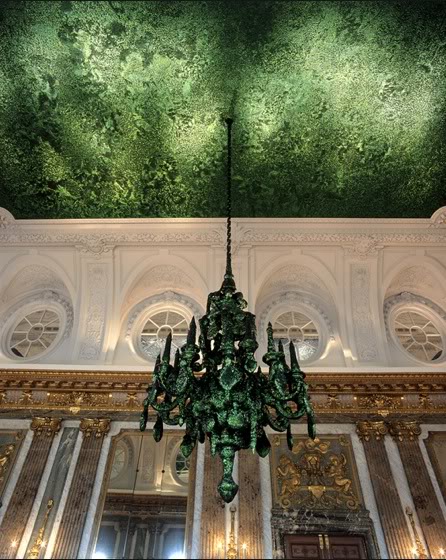Jan Fabre “Pietas” (2011)
by Azahara Garcia
“I’m a contemporary mystic” chuckles Jan Fabre at the end of this artnet interview and, in view of his work above, one has no choice but to revere and agree.
Pietas has been termed a contemporary reinterpretation of Michelangelo’s original where the artist creates a dialogue between art, metaphysics and science. This dialogue is timeless and universal, yet nonetheless poignantly relevant to our times. The global crisis has not only spurred an overall questioning of the predominant lef-brain lateralisation of western culture, but also of consciousness and of the individual’s place in the world. Beholding the mess we are in, financial, social and ecological catastrophes highlighting the fragile basis of our existence, it is only natural to suspend our skepticism and keep seeking a spiritual answer, for in our hopelessness it seems only a miracle can save us. Yet, in the information era, we are not in the dark as to the origin of world problems and how, and if, we can solve them. We have the technology, the science and the resources to make a difference. Our brains have made us godlike, yet we need art to remind us of what is obvious to both science and religion, that we are inexorably linked to the natural cycle of death and decay.
Death is indeed a key concept in this work, as “Fabre insists that Pietas should be interpreted as a ‘performance sculpture’ that encapsulates maternal bereavement and captures the futile longing of a mother to take the place of her dying son.” However, the stern material solidity of marble, the exquisite anatomical accuracy of its models, and the presence of flora and insect motifs make it as well a celebration of the very vitality present at the moment of decay. Death takes centre place as the quintessential mother figure (Mary/Nature), who brings forth the possibility of metamorphoses and continuation.
This is doubtlessly a controversial notion for some and, like all good art, Pietas caused a scandal when it was first exhibited at the Nuova Scuola Grande di Santa Maria della Misericordia in Venice for its perceived blasphemous content. The site, a deconsecrated 16th century church transformed into “an academy of thinking” mesmerized Fabre, who “knew this was the right place to exhibit my work! Here, art science and spirituality meet and blend.”
The brain emerges here as a symbol of empathy for the artist, in Fabre’s own words “[Italian Scientist Giacomo] Rizzolati has proven that empathy is a feeling that doesn’t come from the heart, but comes directly from the brain and is registered in our neurons,”. Changing their shoes for felt slippers, visitors walk over an otherworldly scenario covered in 24 carat gold leaf in a solemn and theatrical pilgrimage that takes them from the central brain posts (Pietas I, II, III, IV), to the principal piece Merciful Dream (Pietas V) where the artist lies dead in place of Christ in the lap of Death/Mary. This way the artist invites us to interact with the sculptures and through reference to the senses (spider, roses) question our ephemeral experience of the world, as well as our attempts at transcendence through religion (the crosses of nails and roses stand for Christianism, the bonsai for Japanese Shintoism, the turtle for Chinese, Indian and ancient Greek belief systems), while hopefully coming to terms at the end with our unavoidable mortality (vanitas).
Pietas masterfully and poetically shapes the artists’ deeply personal inner world, articulating a complex and obscure mythology pregnant with references to resurrection, transformation and eternal life. This takes most significant shape in the butterfly perched at the artist’s face, and in the green amulets hanging around the sculptures covered in buprestids (jewell-scarab wing cases), a signature material reminiscent of Egyptian art, with which he also covered the Hall of Mirrors in the Royal Palace in Brussels in his work below entitled Heaven of Delight (2002).
Despite its apparent focus on mortality and human ephemera, Pietas is a monumental masterpiece intended, like those of the old masters, to endure and perdure. In the artist’s own words:
“I love the durability of things. I create for the future. I believe that my work contains many riddles and layers, which will reveal themselves more clearly to the beholder in, say, 50 or 100 years. Only then will my work be better understood. I find it such a beautiful thought: we live in a society where no one is concerned with durability, while artists are precisely engaged with issues of durability. Durability is a rather old-fashioned concept. You are no longer allowed to believe that your work will have value in, say, 100 years. I believe, on the contrary, that its significance will increase. I would stop making art if I believed that my work could hold no future meaning.”
It is fair to conclude that, as much as western secular society aims to disentangle itself from religious morality and subsequent censorship, the fact that Fabre’s work is still perceived as scandalous means that we are far removed from aseptic curiosity when it comes to our relationship with spirituality. Although the insistence of imposed religious views to obscure or repress our hunger for knowledge, for experience of the world, for enquiry and reinterpretation through a variety of means is truly sad; a yearning for an afterlife, for a notion of permanence to hold on to is a healthy and dignified symptom of the human malady. My proposal here is that art fills that void in representing that very yearning, and in fixing it for posterity,like Fabre does, we find unshakable hope for generations to come.





[…] http://twistedsifter.com/2012/04/adding-monsters-to-thrift-store-paintings/ http://visceralia.com/2013/09/06/jan-fabre-pietas-2011/ […]